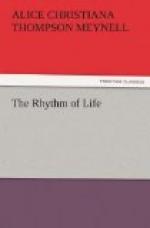‘Seek to have less rather than more.’ It is a counsel of perfection in The Imitation of Christ. And here, undoubtedly, is the secret of all that is virile and classic in the art of man, and of all in nature that is most harmonious with that art. Moreover, this is the secret of Italy. How little do the tourists and the poets grasp this latter truth, by the way—and the artists! The legend of Italy is to be gorgeous, and they have her legend by rote. But Italy is slim and all articulate; her most characteristic trees are those that are distinct and distinguished, with lines that suggest the etching-point rather than a brush loaded with paint. Cypresses shaped like flames, tall pines with the abrupt flatness of their tops, thin canes in the brakes, sharp aloes by the road-side, and olives with the delicate acuteness of the leaf—these make keen lines of slender vegetation. And they own the seasons by a gentle confession. Rather than be overpowered by the clamorous proclamation of summer in the English woods, we would follow June to this subtler South: even to the Campagna, where the cycle of the seasons passes within such narrow limitations that insensitive eyes scarcely recognise it. In early spring there is a fresher touch of green on all the spaces of grass, the distance grows less mellow and more radiant; by the coming of May the green has been imperceptibly dimmed again; it blushes with the mingled colours of minute and numberless flowers—a dust of flowers, in lines longer than those of ocean billows. This is the desert blossoming like a rose: not the obvious rose of gardens, but the multitudinous and various flower that gathers once in the year in every hand’s-breadth of the wilderness. When June comes the sun has burnt all to leagues of harmonious seed, coloured with a hint of the colour of harvest, which is gradually changed to the lighter harmonies of winter. All this fine chromatic scale passes within such modest boundaries that it




